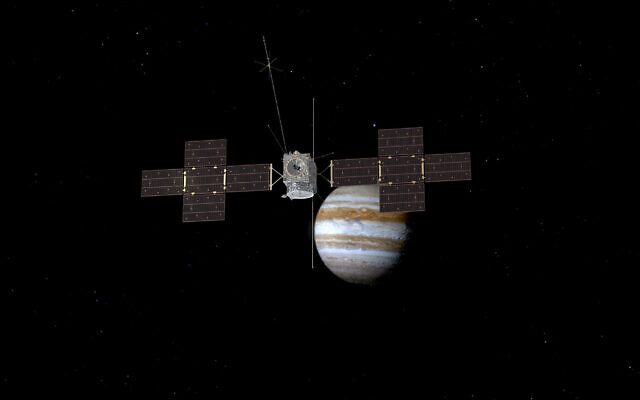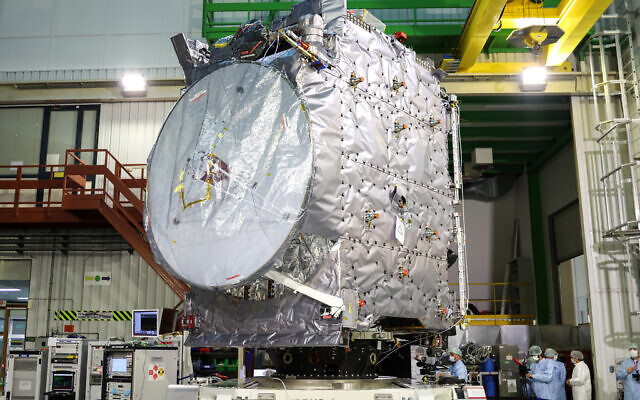KOROU, French Guiana (AFP) — The European Space Agency’s JUICE space probe successfully launched Friday on a mission to discover whether Jupiter’s icy moons are capable of hosting extraterrestrial life in their vast, hidden oceans.
The launch on an Ariane 5 rocket from Europe’s spaceport in Kourou, French Guiana came after a previous attempt on Thursday was called off due to the risk of lightning.
Once it reaches the planet in 2031, the Jupiter Icy Moons Explorer, also known as JUICE, will deploy a range of scientific instruments, including one designed and managed by Israeli scientists, to get a read on the gas giant and its moons.
Despite cloudy skies, the rocket took off as planned at 9:14 a.m. local time on Friday, as guests including Belgium’s King Philippe watched from the Guiana Space Centre.
A little under half an hour later, the uncrewed six-ton spacecraft separated from the rocket at an altitude of 1,500 kilometers (930 miles), which prompted an outbreak of applause at the center.
Get The Times of Israel’s Daily Edition
by email and never miss our top stories
By signing up, you agree to the terms
Stephane Israel, the CEO of French firm Arianespace in charge of the rocket, said the launch was “a success.”
After a few tense minutes, ground control were relieved to receive the first signal from spacecraft.
The spacecraft then began unfurling its array of solar panels, which are a record 85 square meters, the size of a basketball court. It will need all the energy it can get near Jupiter, where sunlight is 25 times weaker than on Earth.
This image provided by the European Space Agency depicts the Jupiter Icy Moons Explorer, Juice, spacecraft orbiting the gas giant. (ESA/ATG Medialab via AP)
Carole Larigauderie, JUICE project head at France’s space agency CNES, said the launch was the beginning of a long journey which will “not be at all calm.”
The probe will take a long and winding path to the gas giant, which is 628 million kilometers (390 million miles) from Earth.
It will use several gravitational boosts along the way, first by doing a fly-by of Earth and the Moon, then by slingshotting around Venus in 2025 before swinging past Earth again in 2029.
When the probe finally enters Jupiter’s orbit in July 2031, its 10 scientific instruments will analyze the Solar System’s largest planet as well as its three icy moons Europa, Ganymede and Callisto.
Among those tools is a Ultra Stable Oscillator developed by the Israeli firm Accubeat, which will measure variations in a radio wave beamed at the moons’ surfaces to detect if anything is moving or causing ocean tides to become irregular.
The instrument is being handled by scientists from the Weizmann Institute of Science’s Earth and Planetary Sciences Department, and the project was funded by the Israel Space Agency.
The moons were first discovered by astronomer Galileo Galilei more than 400 years ago, but were long ignored as potential candidates for hosting life.
However, the discovery of huge oceans of liquid water — the main ingredient for life as we know it — kilometers beneath their icy shells has made Ganymede and Europa prime candidates to potentially host life in our celestial backyard.
JUICE will focus on Ganymede, the Solar System’s largest moon and the only one that has its own magnetic field, which protects it from radiation.
In 2034, JUICE will slide into Ganymede’s orbit, the first time a spacecraft will have done so around a moon other than our own.
NASA’s Europa Clipper mission, which is scheduled to launch in October 2024, will focus on Ganymede’s sibling Europa.
‘Extraordinary mission’
Neither mission will be able to directly detect the existence of alien life, but instead hope to establish whether the moons have the right conditions to harbor life.
Larigauderie pointed out that a kind of mucus had been found in a lake underneath a glacier in Antarctica, showing that life can survive in such extreme environments.
“If JUICE manages to prove that Ganymede is habitable so that we can go and find out in the future that there is life, that would be fabulous,” she added.
French astronaut Thomas Pesquet, who attended the launch, told AFP that “space exploration is pushing back the frontiers of knowledge in small steps”.
“If we are in a position to return to the Moon in a few years, it will be because of robotic precursors,” he said. “Robotic and crewed exploration are two parts of the same effort.”
The 1.6-billion-euro ($1.7 billion) mission will mark the first time Europe has sent a spacecraft into the outer Solar System, beyond Mars.
The ESA’s ‘Juice’ probe is unveiled for media in Toulouse, southwestern France on January 20, 2023, a few days ahead of its departure to Kourou space center. (Charly TRIBALLEAU / AFP)
“This is an extraordinary mission that shows what Europe is capable of,” said CNES chief Philippe Baptiste.
Friday marked the second-last launch for the Ariane 5 rocket, before it is replaced by the next-generation Ariane 6.
Repeated delays for the Ariane 6, as well as Russia pulling its Soyuz rockets in response to sanctions over the war in Ukraine, had left Europe struggling to find ways to launch its mission into space.
Times of Israel staff contributed to this report.



